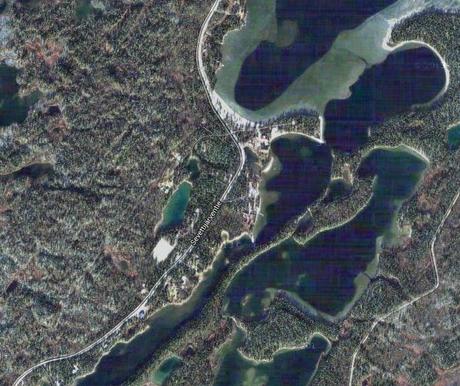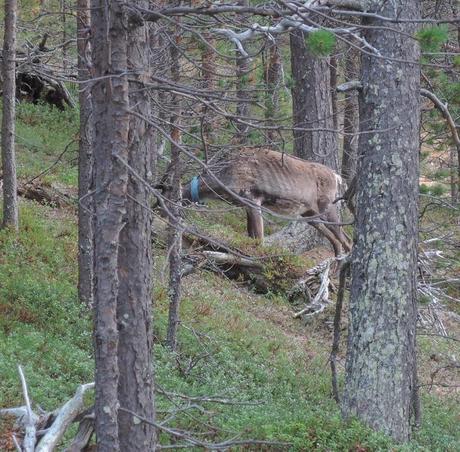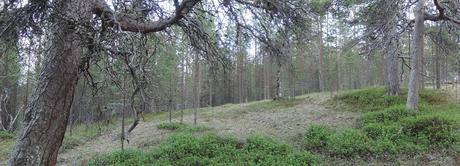
But Inari has by no means been just indulging myself in longings and self-pity. Actually, as to coincidences and new contacts, it has turned out one of the liveliest days in the journey so far. To start with, there is the young Spanish couple who work for free in Villa Lanca, whose presence in Inari has somewhat surprised me. Who was to say, seven thousand kilometres from Spain, in such a tiny and forlorn place I’d find two fellow countrymen? And such a nice couple, for that matter! They’ve been very kind to me, going further than their duties as hosts and sharing their time and experiences with me.
Beside them, it turned out there were another three Spaniards staying at the same hostel, a somewhat shy guy who told me he was also a biker, but now traveling in a rental car, along with his wife and child, guess where to? Yes, to Cape North. But this wasn’t everything, because late in the evening another couple from Spain arrived: Guillermo and Olatz, two very agreeable basques journeying in a red Volkswagen T3 van, quite a classic. With them I’ve spent a nice while and got on quite well this morning, right before parting, each to our own destination, pity. I confess I’ve taken a liking to them, as they seemed to be merry and optimistic, the kind of people I’m usually fond of, unassuming and good natured. By the way, at farewell time they didn’t hesitate in inviting me to pay them a visit in Bilbao if Rosaura takes me to that side of Spain whenever I return.
So, there you are!: eight Spaniards meeting by sheer happenstance in a remote small Lappish town. And, to crown it all, I’ve also come across the three Germans I met two days ago in Savukoski, that family riding on a motorcycle with a sidecar and heading you know where: certainly to Cape North. However, these coincidences, chance as they might seem, are not so extraordinary when taking into account–as I said in a previous chapter–that Nordkapp is a major touristic destination (actually a real tourist trap, some people have already told me), and that but for some small byroads there are very few routes going there: one along Norwegian coast and this one through Lapland; the latter, going past Sodankylä and Inari, is the drivers’ favourite for “going up”, leaving the other one for “coming down”, the second half of their trips. Thus, Inari is a narrow bottleneck through where virtually every person heading to Cape North must pass, sooner or later.
But once passed, Rosaura and me, here’s where we branch off the main tourist stream and, instead of keeping straight to the north, take route 971 to the northwest, perhaps one of the quietest roads in Finland, taking to one of the less known borders with Norway: Näätamö. However, before venturing that way I’ve got acquainted with the existence of at least one inn thie side of the border, given the considerably higher prices beyond; and for this errand I’ve resorted to a couple my friend Pascal directed me to, for whom he had been working many years ago, and who run a small Lappish jewelry workshop called Inarin Hopea. Upon asking them about some acommodation along route 971 they’ve recommended me the–perhaps–only possible one: Toini Sanila reindeer farm. Thus assured, then, I set out on this day’s journey.
It’s a cloudy, grey and windy morning, which rounds off the drastic weather change we’ve had along the past forty eight hours, temperatures dropping more than fifteen degrees; and I’ll be lucky if it doesn’t rain before the evening. The thing is, according to locals the weather for this time of the year wasn’t quite normal with highs of thirty degrees before today’s change, but as cold as today, August 9th, isn’t normal either, as we’ll probably won’t reach fourteen. Let’s put the blame on climate change.
I exit Inari via E75, the Arctic road, and a few kilometres further on I overtake Guillermo &∓ Olatz’s van, as they’re driving even slower than me. We wave at each other and, little by little, they become small on my view mirror; but when I come to the junction with route 92, the one which goes towards Nordkapp, I realize I’ve missed the fork I wanted to take; road 971 is so nonimportant and solitary, it’s easy to overlook. When I’m studying the map, the basque’s van goes by me, and I see them merrily greeting me behind their red Volkswagen’s windshield. I won’t catch up with them any more along this trip. My way branches off everybody else’s when I turn round and take, now correctly, the route towards Sevettijärvi.
It’s worth noting that, after fifteen hundred kilometres crossing unvarying–though impeccably beauty–landscapes, finally this part of Finland’s environment has changed to something sensibly different: the land is very stony, prevailing loose rocks; vegetation is staler and sparser, conifers losing their preponderance; and most interesting, the waters are clear!; they don’t have any longer that dark tinge so prevailing in Finland, but are colourless and transparent; which means, I guess, that this corner of the country has a different geological substratum than the rest.
For a while now I’m feeling like grabbing a beer and a snack, but not a soul seems to live along this way. Eventually, after three hours riding, not far from my destination I come across a locality called Sevettijärvi; and I mean “locality” instead of “town” or “village” because Sevettijärvi is smaller than one of those cortijos (ranches) in Extremadura, my homeland; even its name is larger than the place: barely half a dozen spread out houses, a pub and an Orthodox church, connected by dirt tracks. You know, the arsehole of the world.

That group of houses in the middle of the wood is Sevettijärvi
But, well, a pub means beer and, gee!, I like this kind of places; as a matter of fact I’m quite pleased with having found it. I stop Rosaura by the bare, wooden terrace looking over the lake, dismount and walk to the door. The floorboard bestow a strong gravity to my steps. Upon coming in I see myself in a room with a bar, untended, and a few tables where some people talk who pay me no heed. At the far end there’s another door from where lively noise of conversations and dinnerware comes. I cross the room and, behind the second door, I come to a lounge where two or three dozen people sat at two long tables, obviously celebrating something. Then someone standing spots me, a woman, and comes towards me; but ere she can address me I’ve already asked, is this a private party? Indeed, it’s a wedding–she says–and the pub is closed to the public, sorry. I Russian wedding, I reckon, judging from the language most people are talking. “It make sense”, think I, mentally connecting the Orthodox church and the nearness of Russia. Pity not to be one of the guests! Beer will have to wait.
Out of curiosity three or four guests follow me outside, and watch me as I’m putting on gloves and helmet. I reckon they see a dark skinned foreigner on faded beige, worn trousers, a bone-coloured bike-jacket and golden kerchief, pulling down a white jet helmet and adjusting black gloves, then sitting astride on an untidy brick-coloured motorcycle, turning the engine on and riding slowly on the dirt track. Then they see the plate, and some will ask is it Estonian? Believing themselves nonunderstood, they don’t care to speak quietly, and as I move away I overhear someone replying: Ispaniya.

Reindeer grazing among the pinetrees near Toini Sanila
Porotila Toini Sanila is a reindeer farm (such is the meaning of porotila), restaurant and acommodation located on a neck of land betweeen Sevettijärvi and Kirakkajärvi lakes, fifteen kilometres from the Norwegian border. The property is self-described as meeting point of the Finnish, Samish and Norwegian cultures… a versatile accoommodation and meeting place for groups and people travelling alone. Which means, my place and my element. In these kind of business, relations between guests and hosts work somewhat differently compared to the standards; for instance there seems to be no room nor reason for mistrust nor formalities: he who arrives here has not come for cheating on anyone, and the same goes for whomever runs such a business. Only a warm and sincere hospitality, or even familiarity, makes sense. And that’s exactly how the landlady has welcomed me, making feel at home.
Despite the isolation, all rooms in the main building are booked, but there are a few empty cabins. She hands me the key to the nearest one, plus a jar of water, and tells me I can use any of the bathrooms (even those reserved to the staff) and also the sauna–which will be free in half an hour–at no additional cost. I gladly accept, because a sauna session is very welcomed in such an unpleasant weather as today’s. I find the cabin to be enough for me, scantly furnished as usual: two beds with thick duvets, a powerful electric heater and a small table. I don’t need more for spending the night.
As usual, sauna makes me a brand new man: toned up, clean and rested. The temperatures contrast is what matters, as I always say; and the contrast was granted today, because cold water came chilled out the pipes. Having some time left until dinner time, I get into the wood for a ramble, and before long I find myself in a strange, eerie setting; so much so, the shots I take don’t give it its due, unfortunately; I’ll have to rely on words.

Wood near Toini Sanila
It’s a sparse wood with small and tortured conifers among whose tops the wind blows a murmur filled with misterious whispers, as if coming from the other world. The ground is totally covered with a cushiony, thick layer of moss and humus, on which my foot sink leaving no track whatsoever, and which buffers the noise of my steps. When I stop to listen, the wind quietens down in an uncanny, dismal silence, as if one hundred goblin’s eyes were spying on me; but upon resuming my walk then again the wind plays its rustling on the withered foliage of the trees. There’s a ghastly, unreal and fantastic note onto everything. All over the place, the half rotten carcasses of broken off branches. And what a secluded place, this forgotten pine forest in the remotest corner of Finland! You can’t come farther. Only spirits can dwell here, like the Indian cemetery in Jeremiah Johnson. It must feel dreadful–bloodcurling–to be in this place under a heavy snowfall…
Eventually I get to a small lake of limpid waters, whose gentle ripples come to die in tiny little waves onto the shore’s boulders with a hollow slap. And this calm of the lake in a windy day like this only makes for a more spooky feeling.
When I turn back the irrational, fleeting fear seizes me of having got lost, but luckily a sunbeam makes its way through a gap opened on the clouds that points me in the right direction; and, under this new reddish hue, all of a sudden the forest seems to lose its uncanny look: it’s just a wood like any other.

A sunbeam puts a reddish hue onto the trees
Once back in the farm I sat in the dining room to dinner, asking for the kind landlady’s advice about a dish. She recommends me the reindeer meat with blackberry jam. Delicious. You don’t very often get food as tasty and healthy and natural as this. Finally, while drinking a cuppa, I peruse the superb photographs displayed on the room’s walls: among them, there’s one that mesmerizes me for its strength: it’s the black & white face of an old native sami, his countenance strikingly expressive. Chance has it so that the picture author is here now, sitting at a table, sharing the landlady’s company. I can’t but congratulate him for his art.
It’s already dusk when I go to my hut for reading a while before getting to bed. Outside, the light wanes very slowly, and it’s still clear night when I turn off the lamp. Behind the blindless window panes, the soft blueish dimness will watch over my dreams until dawn.
previous chapter
), restaurant and acommodation located on a neck of land betweeen Sevettijärvi and Kirakkajärvi lakes, fifteen kilometres from the Norwegian border. The property is self-described as

